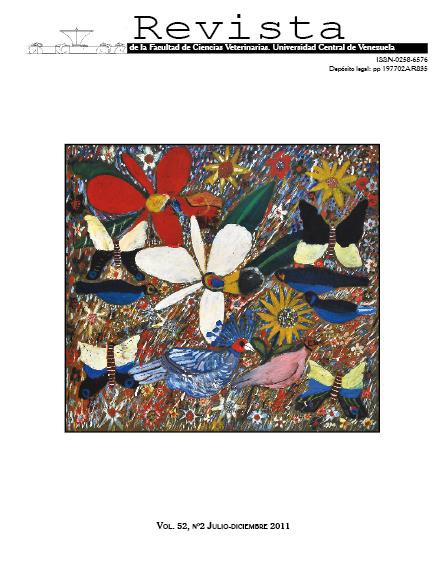Concentración y Morfología de los Espermatozoides Epididimarios Obtenidos de Toros Postmortem
Contenido principal del artículo
Resumen
Con el objetivo de evaluar la concentración y la morfología de los espermatozoides de la cola del epidídimo de testículos de toros postmortem, obtenidos mediante lavado por flujo retrógrado, se recolectaron al azar 90 testículos, los cuales fueron transportados bajo dos diferentes temperaturas, siguiendo dos protocolos diferentes: Protocolo 1 (35ºC) y Protocolo 2 (25ºC), durante el período abril-julio 2003. El material experimental fue transportado desde el sitio de la recolección hasta el laboratorio, en un lapso comprendido entre 30 y 60 min con un promedio de 45 min. Se realizó histopatología para seleccionar los testículos con 70% o más de tejido funcional para cada protocolo (Protocolo 1: n=13; y Protocolo 2: n=20). Una vez realizado el descarte de aquellos testículos que no cumplieron con esa premisa, se evaluó la concentración espermática y la morfología de los espermatozoides de las colas epididimarias en los testículos seleccionados. La recolección de esos espermatozoides se realizó por lavado retrógrado con TRIS-yema-glicerol, a través del conducto deferente. Se determinó la concentración espermática mediante la cámara de Neubauer, en el fluido espermático y la morfología espermática se determinó en función del porcentaje de espermatozoides normales y de las atipias encontradas, previa tinción con Hema III. Los datos se analizaron mediante estadística descriptiva, y se realizó una prueba de t de Student para comparar muestras independientes. Los resultados obtenidos indican que no hubo diferencia significativas, entre los dos protocolos en la morfología normal, ni el total de atipias. Según este estudio, la temperatura de transporte no afecta la calidad espermática epididimaria.
Abstract
In this investigation, the concentration and morphology of spermatozoa of the epididymal tail of post mortem bull testicles, obtained by retrograde flushing, were evaluated. The experiment was done from April-June 2003. Ninety testicles were randomly collected and transported to the laboratory, following two different temperature protocols: Protocol 1 (35°C) and Protocol 2 (25°C). The testicles were transported from the slaughterhouse (Frogorífico Industrial de Turmero, the State of Aragua, Venezuela) to the laboratory within a time frame of 30-60 min, with an average time of 45 min. For each protocol (Protocol 1, n=13; Protocol 2, n=20), a histopathological study of all samples was performed and those testes with 70% or more of functional tissue were selected. After discarding the testicles which did not comply with the required conditions, the spermatic concentration and morphology of spermatozoa were assessed. Spermatozoa collection was carried out by retrograde flushing using TRIS-egg yolk glycerol medium through the deferent duct. The spermatic concentration was obtained using the Neubauer chamber while the spermatic morphology was estimated by observation of smears stained with Hema III, and comparing the percentage of normal versus abnormal spermatozoa. The data
was analyzed by descriptive statistics and the t test was applied to compare two independent samples. The results obtained showed no statistical significant differences between the two protocols, regarding normal morphology and total percentage of abnormal spermatozoa. It is concluded that the two different temperature protocols do not affect the quality of spermatozoa of the epididymal tail.

